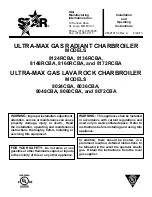
MODULEX EXT 321, 481, 641, 802, 962, 1123 BOILERS
Installation, Operation & Maintenance Manual
Page
16
of
146
AERCO International, Inc.
•
100 Oritani Dr.
•
Blauvelt, NY 10913
OMM-0087_0F
07/13/15
Phone: 800-526-0288
GF-143
•
Less than 49 dBA of noise at maximum power.
•
Heating operation: instantaneous power microprocessor control, with preset parameters for
comparison between temperature (or calculated from the external temperature regulation)
and global temperature flow.
•
Operation modes:
o
Ability to control power to the individual heating elements for any calibration with or
without confidential code access.
o
Production of A.C.S. (Active Cooling System) by NTC sensor of priorities for control by
boiler feed pump or by three-way diverter valve controller.
•
E8 electronic controller included.
•
BCM (Boiler Communication Manager) included.
•
Ability to control power of the individual heating elements.
•
Control of heat demand: constant or remote setpoint.
•
Monitoring of operating status and temperature.
•
Reporting of alarms.
•
Setting of parameters.
•
Emergency operation prevents the boiler from shutting down as a result of the interruption
of communication with a control system or any remote control unit.
•
Alarm management.
•
Alarm reset input.
•
Warning alarm relay.
•
Stainless steel condensate collector tank with siphon, drain trap, and smoke chamber.
•
Easily removable stainless steel panels painted for outdoor installation.
•
Built-in air vent
2.2 General Boiler Operation
The boiler may be operated from the E8 controller or alternatively from a BCM (Boiler Cascade
Manager).
The boiler management logic provides the maximum number of simultaneously operating heating
elements in order to maximize heat production and overall efficiency. Burner efficiency and a high
heat exchange between surfaces contribute to the reliable and efficient output power. The various
components are designed to work together so that operating time is shared equally among the
components, thus reducing maintenance and labor costs.
The hot water moved by the pump is pushed to the return of the primary flow of the hydraulic
separator. From here a second pump will distribute the hot water to the various destinations. The
cooled return water is drawn by the pump through the hydraulic separator to resume the cycle via
the boiler.
WARNING!
If installing to an outdoor location where freezing temperatures may
occur, it is necessary to install devices and/or materials to prevent
any freezing in the condensate drain and the Flow and Return
manifolds. Failure to do so may cause serious damage to the
equipment.
















































